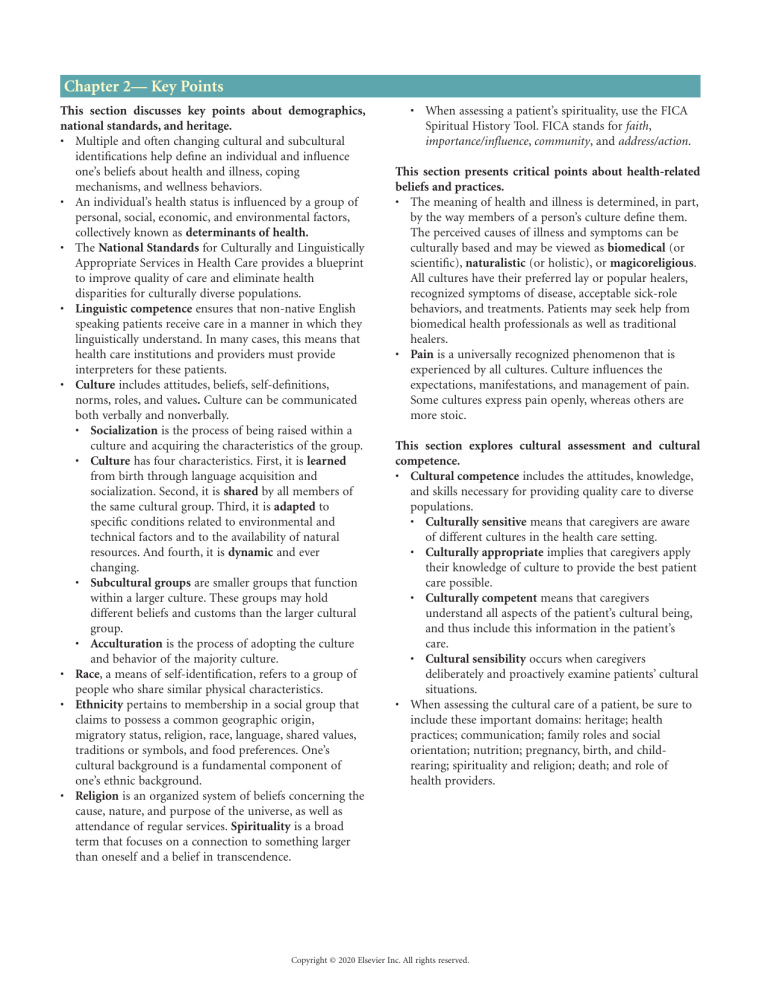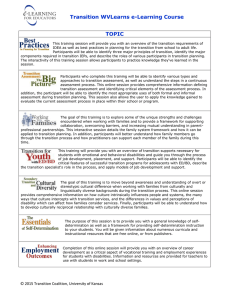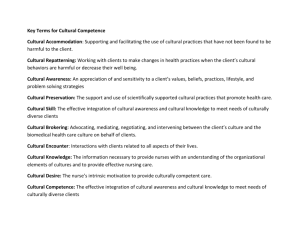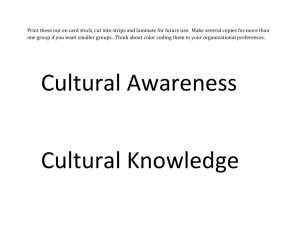
Chapter 2— Key Points This section discusses key points about demographics, national standards, and heritage. • Multiple and often changing cultural and subcultural identifications help define an individual and influence one’s beliefs about health and illness, coping mechanisms, and wellness behaviors. • An individual’s health status is influenced by a group of personal, social, economic, and environmental factors, collectively known as determinants of health. • The National Standards for Culturally and Linguistically Appropriate Services in Health Care provides a blueprint to improve quality of care and eliminate health disparities for culturally diverse populations. • Linguistic competence ensures that non-native English speaking patients receive care in a manner in which they linguistically understand. In many cases, this means that health care institutions and providers must provide interpreters for these patients. • Culture includes attitudes, beliefs, self-definitions, norms, roles, and values. Culture can be communicated both verbally and nonverbally. • Socialization is the process of being raised within a culture and acquiring the characteristics of the group. • Culture has four characteristics. First, it is learned from birth through language acquisition and socialization. Second, it is shared by all members of the same cultural group. Third, it is adapted to specific conditions related to environmental and technical factors and to the availability of natural resources. And fourth, it is dynamic and ever changing. • Subcultural groups are smaller groups that function within a larger culture. These groups may hold different beliefs and customs than the larger cultural group. • Acculturation is the process of adopting the culture and behavior of the majority culture. • Race, a means of self-identification, refers to a group of people who share similar physical characteristics. • Ethnicity pertains to membership in a social group that claims to possess a common geographic origin, migratory status, religion, race, language, shared values, traditions or symbols, and food preferences. One’s cultural background is a fundamental component of one’s ethnic background. • Religion is an organized system of beliefs concerning the cause, nature, and purpose of the universe, as well as attendance of regular services. Spirituality is a broad term that focuses on a connection to something larger than oneself and a belief in transcendence. • When assessing a patient’s spirituality, use the FICA Spiritual History Tool. FICA stands for faith, importance/influence, community, and address/action. This section presents critical points about health-related beliefs and practices. • The meaning of health and illness is determined, in part, by the way members of a person’s culture define them. The perceived causes of illness and symptoms can be culturally based and may be viewed as biomedical (or scientific), naturalistic (or holistic), or magicoreligious. All cultures have their preferred lay or popular healers, recognized symptoms of disease, acceptable sick-role behaviors, and treatments. Patients may seek help from biomedical health professionals as well as traditional healers. • Pain is a universally recognized phenomenon that is experienced by all cultures. Culture influences the expectations, manifestations, and management of pain. Some cultures express pain openly, whereas others are more stoic. This section explores cultural assessment and cultural competence. • Cultural competence includes the attitudes, knowledge, and skills necessary for providing quality care to diverse populations. • Culturally sensitive means that caregivers are aware of different cultures in the health care setting. • Culturally appropriate implies that caregivers apply their knowledge of culture to provide the best patient care possible. • Culturally competent means that caregivers understand all aspects of the patient’s cultural being, and thus include this information in the patient’s care. • Cultural sensibility occurs when caregivers deliberately and proactively examine patients’ cultural situations. • When assessing the cultural care of a patient, be sure to include these important domains: heritage; health practices; communication; family roles and social orientation; nutrition; pregnancy, birth, and childrearing; spirituality and religion; death; and role of health providers. Copyright © 2020 Elsevier Inc. All rights reserved.



